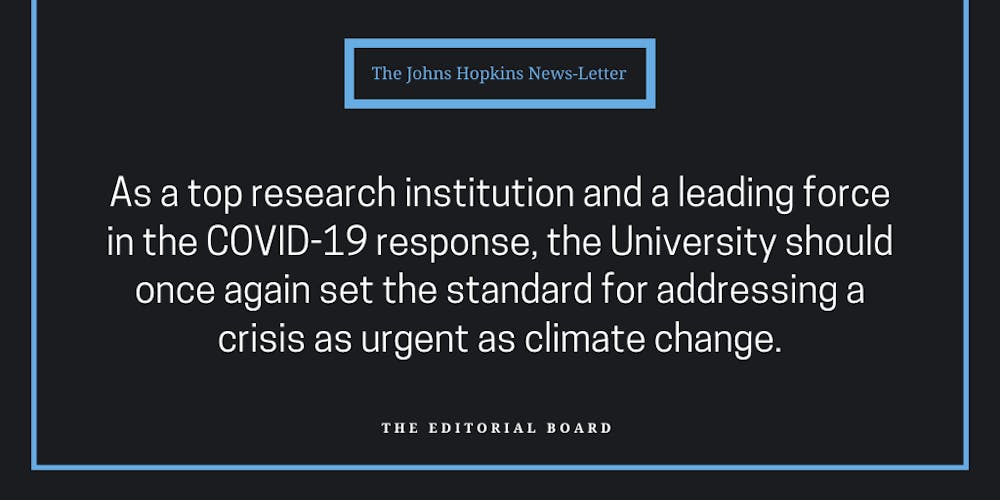If you didn’t know the United Nations’ Convention on Climate Change was happening last month, we don’t blame you. Representatives from almost 200 countries attended the summit, known as COP27, to advance global climate action. Despite its importance, conversations on campus about the conference were slim to none.
In recent years, the United States has made some significant strides toward tackling climate change. This past August, President Joe Biden signed the Inflation Reduction Act into law. The bill is a historic climate investment, allocating $369 billion for initiatives like clean energy production and reducing carbon emissions. As a result, the United States is predicted to achieve Biden’s goal of cutting greenhouse gasses in half by 2030.
As progress is made at the federal level, we want to see Hopkins ramp up its efforts to address climate change.
In April 2021, the University shared its intentions to develop a Sustainability and Climate Action Plan through 2030. The Office of Sustainability has emphasized community feedback as an important part of developing the plan; it held a town hall and conducted a survey of community priorities in December 2021.
We appreciate the University’s efforts to incorporate community feedback into the plan. However, the initial announcement of the sustainability plan promised a finalized version by the end of summer 2022. That goal has since changed to fall 2023, and we have not heard any updates in months.
If the University takes over two years just to develop a sustainability plan, we can’t help but wonder how many more years it will take to actually execute that plan.
We know Hopkins has made some steps to tackle climate change. Two-thirds of the University’s electricity usage is now sourced from clean energy, fulfilling its 2009 goal of reducing greenhouse gas emissions by 51%. This is a huge accomplishment. Yet, given the urgency of the climate crisis, the University should be doing more — and sooner.
Namely, the University should divest from all fossil fuels — not just thermal coal, as it did in 2017. It is estimated that over $400 million of the University’s endowment is invested in fossil fuels, the largest contributor to global climate change. Until this changes, the University’s proclaimed commitment to climate action doesn’t hold water.
Calls for divestment are widespread among experts and academics, and we know it’s possible. Just look at our peer institutions: Harvard, Princeton, Brown, Dartmouth and Georgetown have all vowed to take their money out of fossil fuels. Divestment may even be a strategic business move for universities, as the viability of the fossil fuel industry has been called into question.
It’s clear the University has not kept its commitment to sustainability. That being said, students need to do more to hold Hopkins accountable. Students, alumni and faculty at Cambridge, Stanford and Princeton have all pressured their institutions to divest through protest. In comparison, the climate change discussion at Hopkins has been relatively quiet in recent years.
But not all Hopkins students are strangers to advocacy. Refuel Our Future is a student organization that campaigns for fossil fuel divestment. In past years, this campaign included Fossil Free Fridays, where members of the group held weekly protests on the steps of Gilman Hall calling the University to action.
In 2017, after six years of efforts by Refuel Our Future and a recommendation from the Public Interest Investment Advisory Committee to fully divest from fossil fuels, the University announced it would divest from thermal coal companies. Last year, Refuel Our Future filed a complaint with Maryland Attorney General Brian Frosh that accused the University of violating its nonprofit status through its fossil fuel investments.
We’ve seen other student groups do their part to advocate for sustainability on campus. In 2020, Students for Environmental Action planned projects such as cleanups, upcycling events and even a sustainable fashion show. The Alternative Protein Project raises awareness about alternatives to animal-based protein, which is a major contributor to deforestation and water pollution. These measures are small but still significant ways that students can get involved in the fight to combat climate change.
Some clubs on campus are doing their part, but they only represent a minuscule portion of the undergraduates at Hopkins. With something as universal as climate change, which has sparked youth movements worldwide, we need to see more undergraduates getting involved.
Global emissions need to be lowered by 45% by 2030 to prevent climate disaster. In order to reach this goal, no one can be left out of the fight. Previous generations have often been criticized for leaving the planet in this state, and we need to make sure future youth don’t suffer the consequences of our own inaction.
We as undergraduates have the power to make a change if we all come together and hold Hopkins accountable. Though changing the actions of our University won’t change the actions of the world, it’s a step forward on a crucial path.
As a top research institution and a leading force in the COVID-19 response, the University should once again set the standard for addressing a crisis as urgent as climate change. It’s true that climate change can feel like an overwhelming problem. There is no instant gratification in the fight, which may make it feel like our actions are inconsequential. Yet with patience and dedication, we can make a difference, and it’s imperative we start now.





